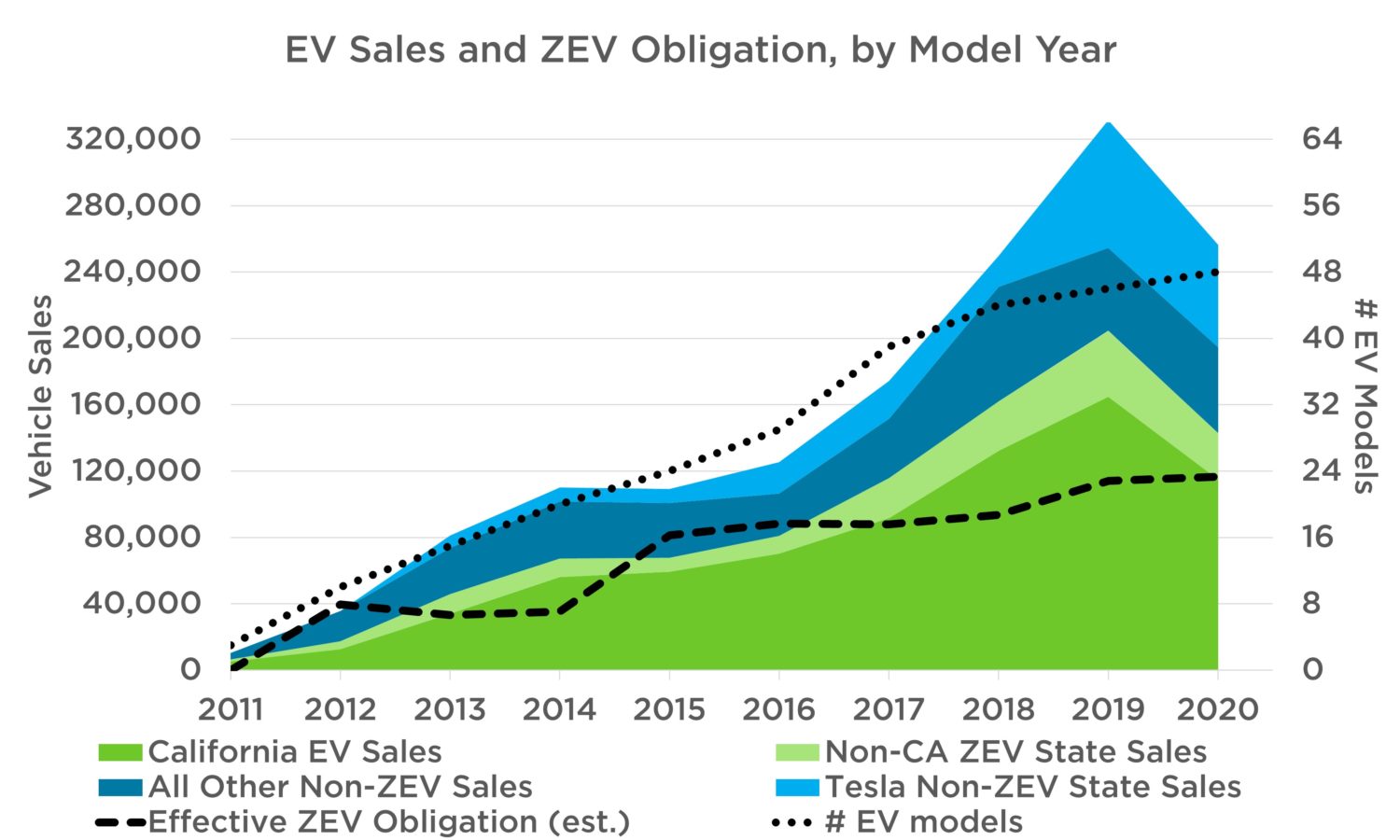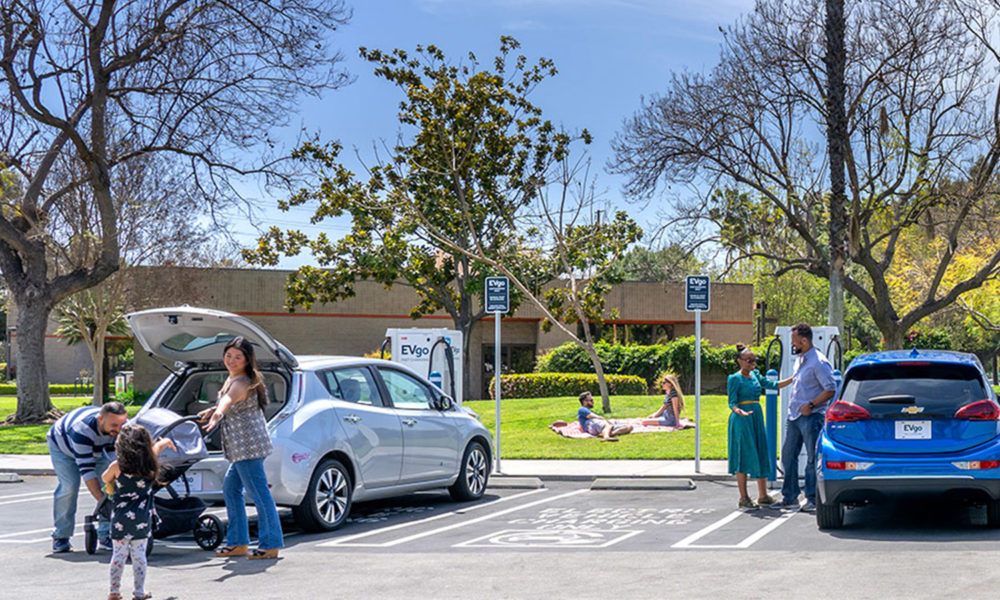A recent New York Times article noted that the Biden administration will be looking to use vehicle efficiency standards to boost electric vehicles sales. Our analysis shows that strong standards are the best way to accelerate toward an electric future and that we need exactly what President Biden called for: “Setting strong, clear targets where we need to go.” However, if the administration is using voluntary agreements with automakers as the basis for its proposal, as reported, we could be in for continued delay in that transformation.
Automakers continue to push for extra credit for the small number of EVs they do sell, just like the voluntary California agreements. Previous standards have already included a number of incentives for electrification, so it’s worth examining both their historical impact and their significance moving forward. This is especially important with the Biden administration set to propose new vehicle standards later this month.
What regulatory incentives are there for EVs today?
Under EPA’s vehicle emissions program, EVs are credited as having zero emissions (emitting 0 grams CO2 per mile [g/mi]). While EVs are cleaner than gasoline-powered vehicles virtually everywhere in the U.S., ignoring the emissions from the grid powering those vehicles means that every electric vehicle sold can actually reduce the global warming emissions benefits of the program in the short term because it allows automakers to sell higher emitting gasoline vehicles than they would have otherwise.
In addition to ignoring grid emissions, for model years 2017-2021 each sale of an electric vehicle is given extra credit—for example, every EV sold in model year 2017 was counted as TWO vehicles, for the purpose of compliance. These credit multipliers lead to reductions on paper towards compliance, ostensibly encouraging automakers to invest in and sell electric vehicles, but don’t actually bring down real-world emissions. Similar to ignoring grid emissions from EVs for regulatory compliance, credit multipliers allow manufacturers to sell higher-polluting gasoline vehicles the more EVs they sell.
There are additional, somewhat comparable incentives under the fuel economy program that are more complex, but the bottom line is this: these EV incentives built into the regulatory standards were intended to support early electric vehicle sales to help with long-term emissions reductions, at the cost of some additional emissions in the short term. The question now is whether this tradeoff is worth continuing.
State EV policies are a key driver of EV adoption
The complicating factor about federal regulatory incentives to spur EV adoption is that states are already leading the way. California set the first zero-emission vehicle (ZEV) sales requirements in the country, and ten states have since adopted those ZEV requirements (with more on the way).
Unsurprisingly, the states with ZEV requirements see more EV models and greater EV adoption. While complementary policies and differences in local demography may play a role, the data is clear: manufacturers preferentially distribute and sell EVs in states with ZEV policies. As a result, while so-called ZEV states make up less than 30 percent of the new car buying market, consumers in those states purchase nearly two-thirds of all EVs.

The EV market is growing
While ZEV sales requirements are driving sales upwards in those states, EV sales around the country are on the rise. Are EV credit multipliers helping to drive that boost? The data raises doubts.
Apart from Tesla’s sales, which skyrocketed beginning in 2017 with the releases of the Model 3 and Model Y (which now make up more than half of all EV sales annually), EV sales have grown steadily, consistent with the pace of growth required by state ZEV policies. While there may be some additionality from federal regulatory incentives (after all, EVs are not sold exclusively in ZEV states), there has been no proportional jump in sales in response to the additional EV incentives. For automakers other than Tesla, sales have remained proportional to the number of vehicle offerings, a number which is also related to increasing state ZEV requirements (since many of those models can only be found in ZEV states).
For Tesla, it is likely that federal EV incentives have helped support growth, since the sale of overcompliance credits to EV laggards like Stellantis (fka Fiat-Chrysler) and Mercedes helps improve profit margins on their EV offerings. However, such credits are reducing the incentive for those companies themselves to invest in electrification, so it is not clear how much of a win even Tesla’s bonus credits are, on net.

Growth in EV sales predominantly coming from Tesla and from sales in ZEV states indicates that federal emissions regulations (applicable to all states) are not a primary driver of EV sales. So if EPA’s incentives are not driving additional sales, overcrediting EVs act simply as a windfall to manufacturers for responding to other policies and incentives. This is especially important to reflect upon when manufacturers like GM clamoring for more of those credits are doing so to undermine the state programs helping to drive adoption.
This means the so-called incentives act only to weaken the federal program, and they are doing so at a significant environmental cost. Since 2011, manufacturers have reduced lifetime fleet emissions by nearly 1 billion metric tons by responding to strong standards set under the Obama administration—however, an additional 66 million metric tons of extra EV credits were used for compliance, resulting in a relative increase in emissions and fuel use of nearly 7 percent over where we’d be without those incentives. (To the extent that the grid continues to get cleaner with time, the long-term impact will be reduced somewhat, but the broader point remains.)
EV regulatory incentives can actually REDUCE overall EV sales
While EPA’s incentives appear to have little positive impact thus far, extending those incentives could be much worse. A recent economic analysis presented at a conference on energy and economic policy noted the potential hazards of overcrediting as EV technology improves:
- Pairing an EV multiplier with a lack of accounting for grid emissions for charging EVs directly, and significantly, reduces the stringency of a standard.
- Automakers have an incentive to sell less-efficient gasoline-powered vehicles under regulations which include a higher EV credit multiplier.
- EV incentives can increase EV adoption rates when sales are small and/or technology costs are high.
- BUT as soon as electric vehicles approach being priced competitively with conventional vehicles, extra credits become likely to decrease EV market share because fewer EVs are needed to comply.
While those first three points are all reasonably intuitive, it is that fourth point which has the most impact as we look to the next generation of fuel economy and emissions standards to help drive the industry towards our climate goals—offering extra credits for EVs could actually reduce the incentive to sell more of them.

This data is consistent with our own analysis, which showed that extending EV credit multipliers would lead to fewer EVs on the road. As both analyses show, any EV sales with all these extra credits drastically reduces the overall stringency of the standard a manufacturer must meet—this reduction in stringency reduces the need for technology deployment to meet the standard (it’s easier), allowing for manufacturers to increase sales of gasoline-powered vehicles at the expense of more EVs.
On top of this, those remaining internal combustion engine vehicles are less efficient than they otherwise would have been, which is particularly problematic when EVs are still a small (but growing) share of the overall new car market. While this may be a gold mine for automakers, it’s disastrous for the environment. Clearly, we need a new direction.
The best way to get more EVs nationwide is setting strong standards
EVs are on the cusp of cost parity, and manufacturers are offering more and more models, including in popular vehicle classes like crossovers and pick-ups. This puts the industry poised to accelerate the transition to electrification. But as we move through that transition, we need to be driving emissions down in our gasoline-powered cars and trucks as well.
The best way to maximize emissions reductions as we move towards a more sustainable fleet is to set standards that are based on the real-world performance of these vehicles and ensure emissions are being reduced across the entire new vehicle fleet. The types of bonus credits manufacturers have asked for push us in the wrong direction, undermine emissions reductions, and are counterproductive for electrifying the transportation system.
Vehicles sold in the next few years will remain on the road for nearly two decades, impacting the climate for many more years to come. As the current administration moves forward to right the wrongs of the previous administration, we need to learn from the data and develop strong policies that will drive the industry forward, not policies with the kinds of hand-outs that have repeatedly delayed climate action. While we need to electrify passenger cars and trucks as quickly as possible, it is critical that our fuel economy and emissions standards not just help accelerate that transition, but do so while driving continued improvements in gasoline-powered vehicles as well.

